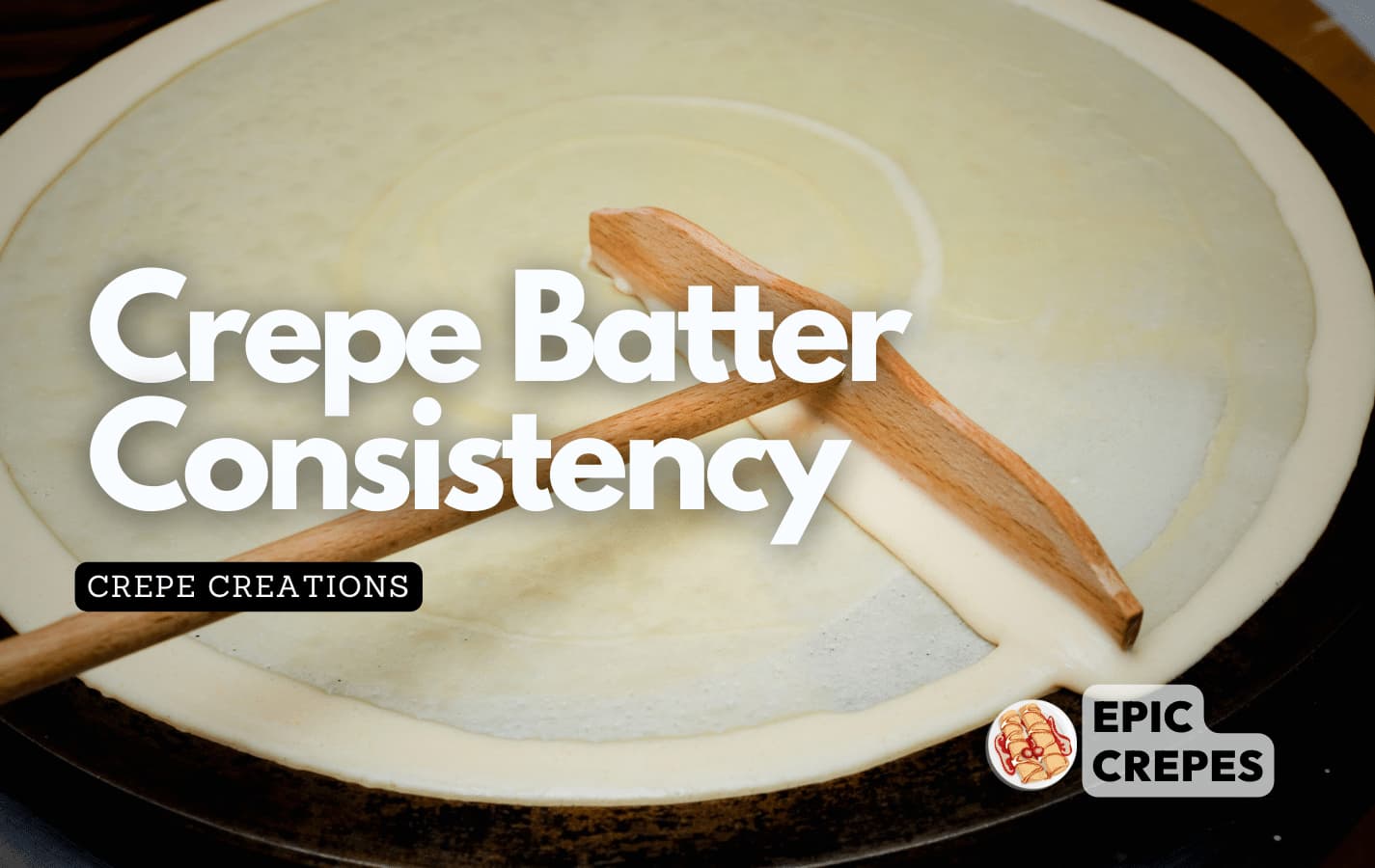If you’ve ever tried your hand at making crepes, you know that getting the batter consistency just right is crucial. Too thick, and your crepes will be heavy and doughy; too thin, and they’ll tear apart before you can even flip them.
But what exactly is the ideal consistency for crepe batter?
First and foremost, it’s important to note that different recipes may call for slightly different consistencies depending on factors like the type of flour used or the desired thickness of the final product. However, there are some general guidelines you can follow to ensure your crepe batter is on track.
In this article, we’ll explore what those guidelines are, why they matter, and how to achieve perfect crepe batter every time. So grab your whisk and let’s get started!
The Importance Of Consistency In Crepe Batter
Have you ever tried making crepes and ended up with a rubbery, tough mess? You may have overlooked the importance of consistency in your crepe batter.
Just like how a smooth, creamy peanut butter spreads easily on toast while a chunky, dry one tears it apart, the texture of your crepe batter can greatly impact its cooking time and end result.
A batter that is too thick will result in dense, tough crepes that are difficult to fold and fill. On the other hand, a batter that is too thin will produce delicate crepes that tear easily and lack structure.
Achieving the ideal consistency is key to creating perfect, golden-brown crepes that are both tender and sturdy enough to hold your favorite fillings.
Understanding the ideal thickness for crepes starts with knowing what texture to aim for in your batter. The goal is to achieve a smooth, pourable consistency that coats your spatula without being too runny or too thick.
With this foundation, you’ll be well on your way to mastering the art of crepe making.
Understanding The Ideal Thickness For Crepes
Measuring the Batter: We need to measure the ingredients accurately to get the right consistency for the crepe batter.
Adjusting the Consistency: Once we’ve got the batter right, we can adjust the consistency by adding more liquid or flour if needed.
Testing the Batter: We should test the batter by pouring a small amount into a pan to see how thick and runny it is.
Making Adjustments: Then, we can make adjustments until we get the ideal consistency for our crepes.
Measuring The Batter
When it comes to perfecting the art of crepe making, measuring the batter is key. The consistency of the batter largely depends on the recipe being used, but generally, it should have a thin and runny texture.
One helpful technique for measuring the batter is to use a ladle or measuring cup to pour an equal amount onto the griddle each time. This will ensure that all crepes are uniform in size and thickness.
Troubleshooting tips can also come in handy when determining the right consistency for crepe batter. If the batter is too thick, it may result in uneven cooking and difficulty spreading on the griddle. In this case, adding more liquid such as milk or water can help thin out the batter.
On the other hand, if the batter is too thin and not holding its shape on the griddle, adding a bit more flour can help thicken it up.
In conclusion, achieving the ideal consistency for crepe batter takes practice and attention to detail. Measuring techniques such as using a ladle or measuring cup can ensure consistent results while troubleshooting tips like adjusting liquid and flour ratios can fix any issues with thickness. With these techniques in mind, anyone can become a master at creating perfectly thin and delicious crepes every time.
Adjusting The Consistency
Now that we have discussed the importance of measuring the batter for crepes, let’s talk about adjusting the consistency.
There are times when the batter may need to be thinned or thickened to achieve the ideal thickness for crepes.
If the batter is too thick, it can result in unevenly cooked and difficult-to-spread crepes. To fix this issue, thinning techniques such as adding more liquid like milk or water can help. It’s important to add a small amount at a time while whisking continuously until the desired consistency is achieved.
On the other hand, if the batter is too thin and not holding its shape on the griddle, thickening techniques can be used. Adding more flour to the mixture can help thicken up the batter. Again, it’s important to do this gradually while whisking continuously until reaching your desired consistency.
By understanding how to adjust your crepe batter’s consistency, you will be able to create perfectly thin and delicious crepes every time.
Factors That Influence Crepe Batter Consistency
After understanding the ideal thickness for crepes, it’s important to know that the consistency of the batter plays a crucial role in achieving perfect crepes. The ideal consistency of the crepe batter should be thin, smooth, and pourable. Achieving this consistency requires proper hydration of flour and appropriate mixing techniques.
One of the key factors that influence crepe batter consistency is flour hydration. Flour needs to be hydrated properly to ensure the right consistency of the batter. You can adjust the consistency by adding more liquid if it’s too thick or adding more flour if it’s too thin. It’s essential to mix slowly while adding liquid to avoid lumps in your batter.
Mixing techniques also play a vital role in getting the perfect consistency for your crepe batter. Overmixing can lead to a tough and chewy texture, whereas undermixing can result in lumpy batter. It’s crucial to mix until you get a smooth and silky texture without overdoing it.
With these tips in mind, you can achieve perfect crepe batter every time.
Tips For Achieving Perfect Crepe Batter Every Time
When it comes to making crepes, achieving the perfect batter consistency is key. But what exactly does that mean?
Well, crepe batter should have a smooth and thin consistency, much like heavy cream. It should be easy to pour and spread evenly on the pan.
To achieve this perfect consistency, there are a few mixing techniques you can try. First, make sure all your ingredients are at room temperature before combining them. This will help them mix together more easily.
Second, sift your flour to avoid any lumps in the batter. And finally, mix the batter just enough to combine all the ingredients – over-mixing can cause tough crepes.
If you find yourself without all of the necessary ingredients for crepe batter, there are some substitutes you can use. For example, if you don’t have milk or cream on hand, you can use water instead. Or if you’re looking for a dairy-free option, try using almond milk or coconut milk.
Additionally, don’t be afraid to experiment with different flours and flavorings in your crepe batter. Buckwheat flour or gluten-free flour can work well as substitutes for traditional wheat flour. And adding vanilla extract or cinnamon can give your crepes an extra burst of flavor.
Remember, practice makes perfect when it comes to making crepes. Don’t get discouraged if your first batch doesn’t turn out exactly as planned – just keep trying and adjusting until you find the perfect consistency for your taste buds!
Frequently Asked Questions
What Is The Best Flour To Use In Crepe Batter?
When it comes to making crepe batter, the type of flour you use can greatly impact the final result.
For those looking for gluten free options, there are several alternative flours that can be used such as rice flour, corn flour or chickpea flour.
However, if you’re looking for a more traditional option, it’s important to choose the right type of wheat flour.
All-purpose flour is a popular choice and produces a thin and delicate crepe while pastry flour will create a slightly thicker and softer texture.
Ultimately, the best flour to use in your crepe batter will depend on your personal preference and desired consistency.
Can I Use Milk Substitutes Like Almond Or Soy Milk In Crepe Batter?
When it comes to making crepes, some people may prefer to use non-dairy milk substitutes like almond or soy milk.
While this may impact the texture of the final product when compared to using dairy milk, it’s important to consider personal preferences and dietary restrictions.
Almond milk can add a nutty flavor to the batter, while soy milk may not affect the taste as much.
Ultimately, experimenting with different types of milk can lead to delicious and unique variations of crepes.
How Long Can I Store Crepe Batter In The Refrigerator?
If you’re wondering how long you can store crepe batter in the refrigerator, the answer is up to two days.
However, if you want to keep it longer, consider freezing the batter in an airtight container for up to three months.
To revive old crepe batter that’s been stored in the fridge or freezer, simply whisk it thoroughly and add a little bit of milk or water until it reaches its original consistency.
Don’t worry if your crepe batter contains milk substitutes like almond or soy milk; they will freeze and thaw just fine.
Should I Use A Blender Or Whisk To Mix The Batter?
Oh, you’re still here?
Well, let’s talk about something important: Blender vs Whisk – Which is better for mixing crepe batter? The answer is… (wait for it)… it depends.
Some people swear by using a blender for smooth and consistent batter, while others prefer the old-school method of whisking by hand.
Achieving the Perfect Consistency: Tips and Tricks for Crepe Batter include adding liquid slowly to prevent lumps and letting the batter rest before cooking.
So, whether you choose to blend or whisk your batter, just remember that practice makes perfect when it comes to crepes.
Can I Add Flavorings Like Vanilla Or Cinnamon To The Batter?
Adding spices like vanilla or cinnamon to crepe batter is a great way to experiment with toppings and create unique flavor combinations.
Whether you prefer a classic sweet crepe with vanilla and fresh fruit or a spiced savory crepe with cinnamon and cheese, there are endless possibilities for customizing your batter.
To incorporate these flavors, simply add them to your batter before cooking, adjusting the amount to taste.
Don’t be afraid to get creative with your spice blends and try out different combinations until you find your perfect match.
Conclusion
So, what’s the deal with crepe batter consistency?
Well, let me tell you, it’s a hot topic in the culinary world. Some people like their crepes thin and delicate, while others prefer a heartier texture.
But let’s get one thing straight: there is no ‘right’ consistency for crepe batter. It all comes down to personal preference.
Now, if you’re anything like me, you’re probably thinking, ‘Who cares about crepe batter consistency? Can’t we just eat the dang things?’
And I hear you loud and clear. But for those of you who are passionate about your crepes (and let’s be real, who isn’t?), it’s important to experiment with different flours, milk substitutes, and flavorings to find the perfect balance of flavor and texture.
So go forth and create the ultimate crepe batter – just don’t forget to invite me over for brunch when you do!




